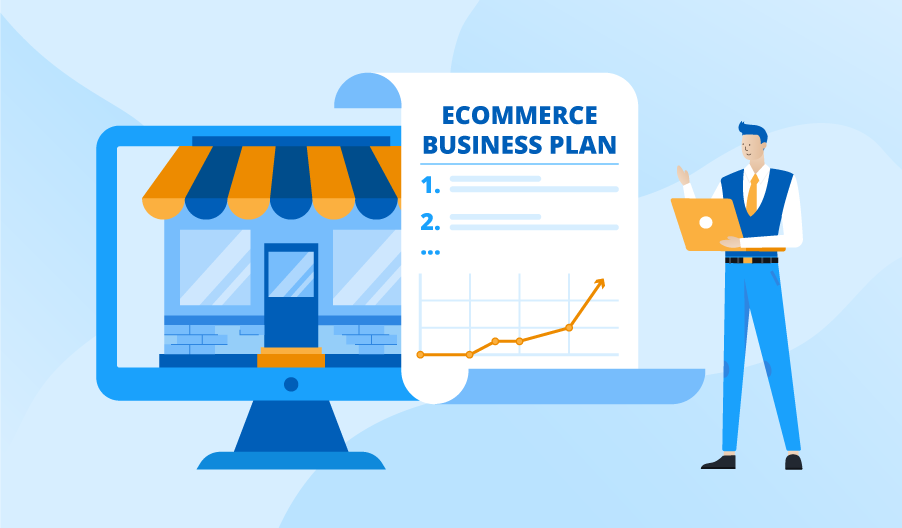Ecommerce Business Plan: a Roadmap to Online Success
Editor’s note: In the article, we explain the importance of an elaborate ecommerce business plan and overview seven sections to include therein. And if you need professional help for a smooth ecommerce market entry, take a look at our ecommerce consulting services targeted to provide solid support for a successful ecommerce launch.
Planning to launch an ecommerce business, you need to build your strategy on substantial market and technology research. It’s important to evaluate the feasibility of your online store, explore the market competition, describe what products or services you will sell, define your mission, decide what technologies will underlie your business operations, and estimate when to expect the ROI.

An ecommerce business plan will help you set clear goals and a clear path towards their accomplishment.
An ecommerce business plan example broken down
Planning an online store requires attention to certain processes and aspects new to entrepreneurs used to dealing with offline businesses. To name one, you will have to work much with technology-related aspects like selecting an optimal ecommerce platform, planning customer-centered design, factoring in regular website maintenance, and more.
To better grasp the whole idea of an ecommerce business plan, let’s consider its rough sample and explore all the important sections step by step.
1. Business description (business overview/about the company)
For convenience, let’s break down this section into two key parts. The first part contains the main information about your business – legal entity, brand name, business type and model, owners, key personnel, web domain, etc. The second part can be considered the ‘creative’ one – it consists of your business value proposition, mission, and vision. It should concisely answer an important question: why consumers should choose your offering among similar competing ones.
2. Opportunity (market analysis)
No doubt, you should analyze the demand for the products or services you’re going to sell. I suggest that you start with a general industry overview – market size, target audience estimation, entry barriers, etc. Study industry reports and whitepapers. Free tools like Google Trends might come in handy.
To understand the target audience better, create personas – fictional characters representing your typical customer segments – and describe them comprehensively including demographic (age, gender, marital status), psychographic (lifestyle, interests) and behavioral (shopping frequency, preferences for digital devices) characteristics.
When you have an understanding of your target market and audience, it’s time to assess the competition more closely. You can research other companies – both online and brick-and-mortar – and draw up a brief summary for each of them emphasizing strong and weak parts of their strategy. This will allow you to avoid similar mistakes and create added value to gain a competitive edge.
3. Products and offers
Describe the types of products you’re going to sell and determine a pricing policy. Focus on the distinguishable features and advantages of your offering – can you tell why people will prefer your products over the competition? Then come up with a plan how to communicate this product value to customer explicitly.
4. Operations
This section should describe all the workflows around your business, basically this will be a plan of daily business operation. Include there all the participants involved in supplying, selling, storing, and delivering products to customers: your suppliers, physical locations involved, personnel, necessary third-party service providers (like shipment and packaging providers).
5. Marketing plan
In an ecommerce business plan, you have to pay enough attention to building brand awareness. Prioritize your marketing channels according to the preferences of the buyer personas you’ve created earlier to target new customers and retain current ones, increase your market share and meet other specific objectives that you set. Estimate the budget for each channel.
6. Financial plan
Business owners see this as the most difficult and important section of a business plan. Indeed, it’s essential for sound financial management and efficient budget allocation. Besides, if you’re seeking additional funds for your ecommerce startup, your financial plan will be the primary source of information for potential investors.
In your financial plan, estimate all the expenses related to your business operation – consulting services, launch and maintenance of an online shopping website, raw product costs, rent, utilities, personnel, marketing, and so on. You can also add a break-even analysis that will give you an idea of how much your ecommerce store should sell in a given period of time to be profitable.
7. Milestones and goals
This section should contain a roadmap for your business evolution to help you stay focused on your goals down the road. Setting up a roadmap at the stage of business planning doesn’t mean that it will be set in stone ever after – on the contrary, you should analyze your business progress routinely and plan strategy shifts if needed.
Your next step to starting an ecommerce business
A sound plan rests on the comprehensive evaluation of your online store’s feasibility, budget, expected ROI, and perspectives. The ecommerce team of ScienceSoft can help you with many aspects like market analysis, technology choice, operational consulting, and, in fact, the implementation of an online store itself. If you want to get started, just let us know.

